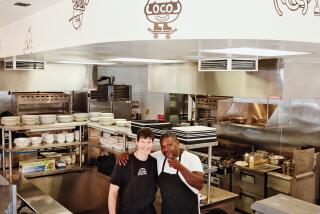Outsiders Get a Look Inside South-Central : Foreign Reporters, Visitors See There Is More to the Area Than Crime, Tension
- Share via
They came to Watts from all over the world to listen to the prophets.
“To light up Chicago, Detroit, Philadelphia, New York, it takes billions and billions of watts . . to light up Los Angeles, it only took one. . . . I remember Watts,” poet Otis O’Solomon chanted to the beat of a bongo. His partners, Anthony Hamilton Amde and Richard Dedeaux, echoed the words to the jazzy rhythm.
Their audience, a group of international journalists and foreign dignitaries, listened attentively as the trio of poets known as the Watts Prophets told the tale of the past, present and future of their community in their unique style.
“The poem, ‘I Remember Watts,’ spans two rebellions,” Dedeaux said the next day at a performance in Long Beach. “The more things change, the more they remain the same. But there’s hope in everything. Something good has to come out of it. . . . Look at us.”
That’s precisely what the Los Angeles Tourism Industry Development Council wanted--for outsiders to look at the cultural treasures of South-Central and its surrounding communities.
The visit to the Watts Towers and its arts center Tuesday was part of a bus tour titled “South Central Renaissance: The Struggle for Community.” Third in a series of “Insight Tours” planned to coincide with the World Cup, the tours were designed to take foreign journalists and visitors to several Los Angeles neighborhoods commonly considered to be smoldering capitals of gang violence and racial tension.
“The purpose was to identify resources in these communities that are in stress and to construct building blocks that will elevate tourism promotion and development,” said Billi Romain, project coordinator of the Tourism Industry Development Council, the nonprofit group sponsoring the tours.
At first, organizers wanted to attract the hundreds of foreign and national reporters that came to cover the World Cup in Pasadena. But a low turnout of soccer journalists prompted the council to invite along other reporters and officials of the tourism industry.
The council also offered tours of East Los Angeles, Hollywood and the Pico-Union/Koreatown districts. Similar tours of these areas after the World Cup are still on the drawing boards, organizers said.
For several months, community organizers and tourism industry workers developed plans and schedules to showcase their cultural and economic regions.
On Tuesday, a busload of 40 tourists--including representatives from the Australian, Dutch, German and Hungarian consulates and reporters from England, Italy and Japan--were driven through southern Los Angeles.
Alberto Crespi, a reporter covering the World Cup for the Italian newspaper L’Unita, said he never imagined that he would venture into South-Central.
“We have a misunderstanding of this area in Europe. The only time you hear about this place is when there’s bad news,” Crespi said as the bus motored up Central Avenue after a stop at the historic Dunbar Hotel. “L.A. is scary when you first get here, but this tour helped me to get rid of a lot of false ideas that I had.”
Legendary for hosting America’s great jazz musicians during the time when African Americans weren’t allowed to stay at other hotels, the Dunbar was a major stop in the five-hour tour. Fire Station No. 30, the first all-black fire company in segregated Los Angeles, and the former Black Panthers Headquarters at 41st Street were also singled out as points of interest.
The tour also stopped at the Watts/Century Latino Organization, where visitors were introduced to African American and Latino leaders. It continued through culturally vibrant Leimert Park and ended at the William Grant Still Art Center, where a reception included a performance of the Caribbean sounds of Bobby Matos.
When the bus stopped at the Watts Towers about midway through the tour, visitors talked to local youths.
“Watts is very stereotyped,” said Jamal Rivers, 17, a resident of Watts and docent at the Watts Arts Center. “Of course, you have the shootings, but the media never comes here to see the good side.”
Hungarian Consul General Andres Marton agreed: “There are so many beautiful things here to see,” he said, looking away from the towers and toward surrounding homes. “Look how they adorn their houses with the beautiful flowers. You can see the hopes and dreams of the inhabitants here.”
The words of hope rang similar to what the Watts Prophets recited earlier in their poem, “Breathe What You Need.”
“Sprinkle the seeds of faith, love, love, love . . . and work early in the garden of the young child’s mind and divineness will occupy its time. . . . “
More to Read
Sign up for The Wild
We’ll help you find the best places to hike, bike and run, as well as the perfect silent spots for meditation and yoga.
You may occasionally receive promotional content from the Los Angeles Times.






